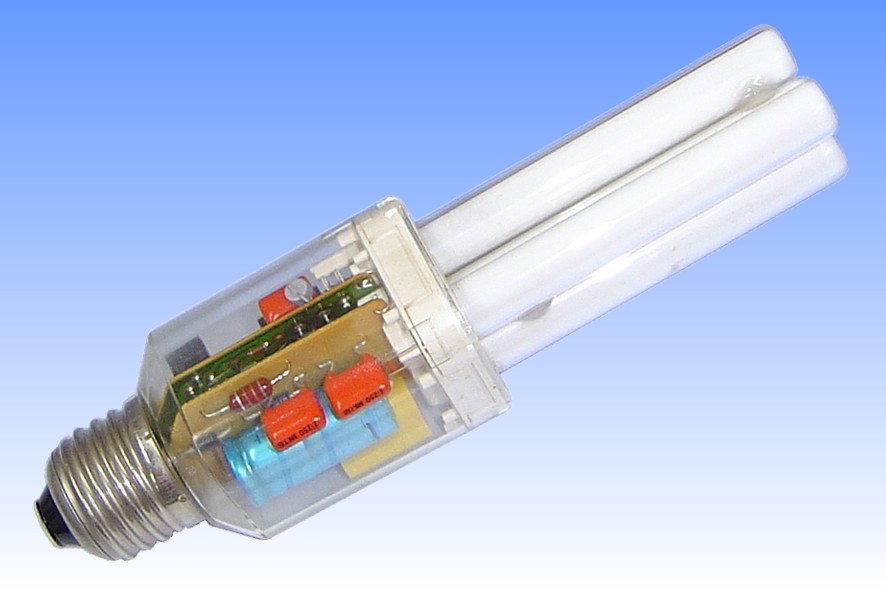
|
PLCE*7 Compact Fluorescent with Electronic Ballast |

The arrangement of the components is visible in this special demonstration lamp, which is made up with a clear plastic base housing. Two printed circuit boards are employed, with surface mounted components on the reverse sides. The ballast operation is not stabilised against mains voltage variations, and there is no end of life shut-down protection. This was for many years a weak point of the Philips lamps. When the electrodes are depleted of emitter and the cathode fall voltage rises, the power dissipation at that part of the tube can rise very high indeed, enough to cause hazardous overheating leading to cracking of the glass discharge tube.
Physically, the lamp consists of four 10mm diameter tubes fused into a square arrangement by the cut-and-kiss technique at three bridging points. The dead regions beyond the bridge act as cold spots to control the mercury vapour pressure, and keep lamp efficacy high. A crucial development that made this lamp feasible was the invention by Louis Vrenken of the rare earth phosphors with an aluminate host lattice, in place of the usual silicates or tungstates. These new materials slowed the rate of lumen depreciation, a degradation process that had always been very fast in tubes of such narrow diameter.
| Manufacturer: | Philips Lighting | |
| Lamp Power: | 7 Watts | |
| Lamp Current: | 0.08 Amps | |
| Lamp Voltage: | 220 Volts | |
| Cap Type: | E27s/27 | Nickel plated brass |
| Bulb Finish: | Triphosphor 827 | Soda-lime glass |
| Bulb Type: | T-10 x 4 | |
| Overall Length: | 161 mm | |
| Mass: | 110 grams | |
| Discharge Length: | ||
| Electrodes: | Triple coiled tungsten | Triple carbonate emitter |
| Atmosphere: | Ar,Kr | Hg | |
| Luminous Flux: | 400 lm | @ 100 hours |
| Luminous Efficacy: | 57.0 lm/W | @ 100 hours |
| Colour Temperature & CRI: | CCT: 2700K | CRI: Ra 82 |
| Chromaticity Co-ordinates: | CCx: 0.473 | CCy: 0.420 |
| Burning Position: | Universal | |
| Rated Lifetime: | 8,000 hours | Rated to 70% survival |
| Warm-up / Re-strike Time: | 3 minutes | Instant re-strike |
| Factory: | Lamp: Roosendaal, NL | Assembly: Terneuzen, NL |
| Date of Manufacture: | August 1988 | Date Code H8 |
| Original / Present Value: | ||
